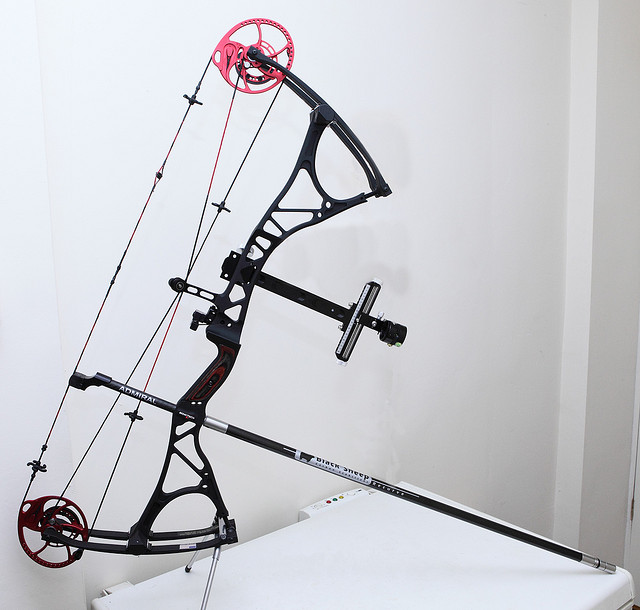
by Jackson | Aug 18, 2014 | Choosing a bow
Choosing a compound bow to shoot is a fun time. I love going through and seeing all the different choices there are. The amount of engineering and technology in today’s bows is very impressive. The only downside to all of that is that there are so many choices which brings me to the purpose today. How to choose a compound bow that is right for you.
I’m a fan of simplicity so I like to go through my choices and think of them like filters. After I’ve made a decision on one thing, I do my best not to look at bows that don’t fit. I know it’s really easy to just see all the choices and get stuck so I try to pare it down as fast as possible.
These guidelines should help you in selecting your own bow and whether it’s your first bow, or your 10th bow, you’ll probably go through similar steps to get the bow you want.
What do you want to do?
Deciding on the purpose of the bow will help you focus on the bows that are right for you from the beginning. If you don’t know exactly what you are going to do with the bow, then think about the options that you’ll probably want to try or use. Some possible choices include hunting, competition archery, olympic archery, field archery, bow fishing, and backyard shooting. For example. If I want a compound bow, then I’m not going to go looking at recurve bows.
What is your draw length?
This is a small point, but it’s an extremely important one. A compound bow’s mechanical advantage only works when it is set to the correct draw length. Make sure that the bow is set for your draw length or can be adjusted to fit it. Otherwise, you’ll end up with some difficult shooting experiences.
What draw weight do you want?
This is more a matter of personal choice and physical ability. Don’t pick a draw weight that is too heavy for you to draw back and make a good shot. If it’s too heavy, you either need to get stronger or choose a lower weight. The draw weight will matter for hunting and that’s about it. You can do most other things without the draw weight being very important.
What archery equipment do you want?
It’s through the attachment of other pieces of archery equipment such as bow sights, release aids, and stabilizers that we get this insanely good accuracy from compound bows. You can add your own equipment that you already own, buy new ones, or buy a bow that comes with some already in place. These are called compound bow packages and I think they’re the best for beginners. You need to make sure that you have all the right parts to attach all the archery equipment to your bow.
Personal choices
All that’s left to do is pick your color choices and any other small bow accessories that you might want. That’s the last thing that you need to do when picking a compound bow.
Now that you’ve chosen your bow, there is one thing left to do.
Choose arrows for your bow
Arrows will need to be chosen and tuned for your bow as well. You can get many different combinations, but you’ll find that if you get a new bow, but don’t get new arrows, you’re leaving a lot of accuracy and skill out of the equation. You can read more on my favorite arrows.
That’s the most important parts of choosing a compound bow. I really wish I could sit here and say this model from this brand is the best, but there are so many good choices now that you really just have to filter through all of them and get the bow that is made best for you and what you want to do with it.
Shoot Straight.
photo credit
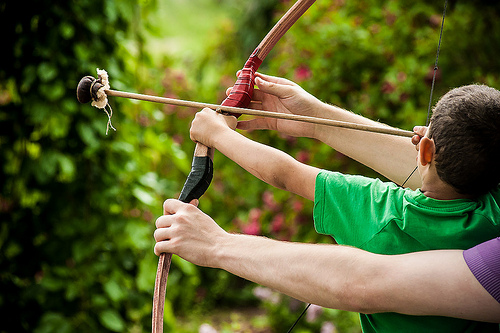
by Jackson | Jul 29, 2014 | Archery Education
Beginning archery is a fun process and many parents will find themselves doing something they don’t know to help their children get started with archery. Knowing how to start archery for kids isn’t too difficult and a bit of learning will go a long way to helping both parents and kids have the most fun as soon as possible.
Here are the things that I’ve found to be some really helpful tips so that you can have the best experience of getting into archery with your kids or any other youth out there.
Get educated
Children are naturally curious and will want to do things that you don’t know anything about. It’s easy to get started and it’s a great chance to help them try something new. The first thing I’d recommend is my Archery Lessons for Beginners to get the right information on how to shoot a bow correctly. It’s going to be really hard to teach your child how to shoot a bow if you don’t know anything about it.
Get the right archery equipment
There are many great choices for your child. You’re very lucky that there are so many good options out there now. You will need to be sure and match a bow to your child and their abilities. Here are the most important things to know when looking at bows.
- Child height or size – You’ll want to buy a bow that is big enough and can be drawn back far enough.
- Relative strength – Most beginners will start at a bow weight of 20#. A stronger youth might prefer a stronger bow up to 30#. A simple test is to see if how many push ups they can do in a minute. 1 = 20#, 5=25#, and 10+ = 30# This is a general guideline and will have to be tailored to each individual.
- Right or Left handed This is easy to figure out. Have your child make in imaginary bow and arrow and draw it back to their face. Whichever hand comes back to the face, that’s the answer. If they pull back with the right hand, they need a right-handed bow. Most people will pull back with their dominant hand and it will normally line up with their dominant eye.
Minimum Equipment List
A Bow
You want a bow that has the right draw length and draw weight. If you don’t know which type of bow you want, get one that has a variable draw length or a traditional bow. Two good examples are:
Samick Sage Recurve Bow
, I recommend this to anyone who is starting archery. It is able to grow with your child as once your have the initial bow you can purchase different limbs later to increase the draw as your child grows. Check out the reviews on Amazon; and the
Genesis Bow Kit
, this is a great bow kit for all the family, including mum and dad. The draw weight can be adjusted if necessary for smaller children. The range is about 20 yards, ideal for most backyards or just practicing.
These are both amazon affiliate links so you can check out the products
Arrows
Generally a beginners archery set will come with 3-6 arrows, over time these are going to break and pieces are going to come off, so buy some extras. Arrows can disappear really fast. Whilst learning I would start with fibreglass arrows, these can be purchased for about $3 each. If buying for a junior normally the 28″ arrow would suit depending on the child’s strength and the type of bow.
Arm Guard
Learning archery needs to be fun and one of the most common injuries and pain, whilst learning is the bowstring striking the wrist. Stop it from the beginning. Who wants to shoot a bow when it hurts? I recommend getting a arm guard for all learners, the
OMP Youth Armguard,
offers good protection for under $10.
Target
You need something to shoot at. You can make your own target, or get something like
The Block Archery Target
, designed to last for a very long time.
Keep it short and fun
As an adult, I have a short attention span. As a child, it was even shorter. Most kids are the same way, so don’t expect them to want to stand and shoot for hours of endless ecstasy on end. 10-15 minutes is long enough for many and you want them to leave happy and excited so they have positive memorize to make them want to keep shooting in the future.
Engineer success
Having a first positive experience is really important with archery for kids. Take some time and learn to shoot a bow real quick, then get the right equipment for them. The third part is to stand extremely close to the target. Seriously, maybe 5 steps away. You want to be so close that it’s almost impossible to miss. You can always move the target farther away, but for some reason it always comes across weird to move it up.
Make friends
There are tons of people and other kids that shoot. Ask around and I’m sure you’ll find some that are in an archery club or have a target setup at their house. It’s a fun way to hang out and you can meet new friends that way. Or, you can get your own friends into archery with you.
I hope these help you to figure out what you need in order to have a good experience. I love archery and it’s been something that I’ve been able to do for years. I’d love the same thing for you and your family too.
Please share if you know anyone who might be interested in archery. It will help them to get started in the right direction.
photo credit
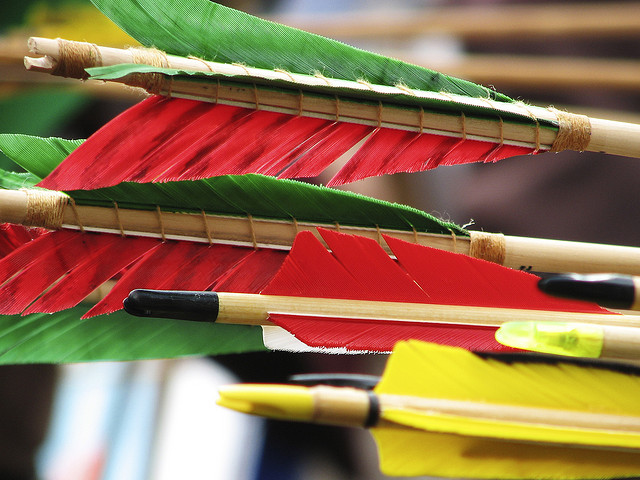
by Jackson | Jul 22, 2014 | Archery Education
There is a lot to know about the different types of arrows available for archery. I’m going to try to give you the basics to help you understand the differences between them so that you can choose the right ones for you.
The first thing that you need to know about arrows is that they are extremely important to the accuracy you get. You can’t just shoot anything from a bow and expect to have great results. Arrows need to be tuned to each bow individually for the best results. I don’t want it to sound too complicated, but there are some things that you need to know to get the right arrows.
Arrow Spine
Arrow spine is the word that describes the stiffness of an arrow. When you loose an arrow from the bow, it undergoes compression and will bend either a little or a lot. You will want to match the spine of the arrow to what you’re shooting. Compound bows will typically favor stiffer arrows and traditional bows will favor more flexible arrows. Don’t worry because almost all manufacturers will have a chart to help you choose the proper arrow.
Fletchings
Most fletchings are plastic vanes but they can also be made from feathers. These give an arrow stability in the air and allows you to have great accuracy. Fletchings can make arrows fly straight with or without spinning. The only thing you need to know about fletchings are that compounds will use solid vanes and traditional bows with use feather style vanes.
Inserts, nocks, and arrow tips
The part of an arrow that attaches to the back and to the string is the nock. Nocks are important, but the main thing is to make sure that they are just keep the arrow on the string without being too tight or too loose.
An insert goes in the front end of the arrow and lets you change out arrow tips. Arrows are cut to the length desired and then the insert is glued in permanently. Some arrows will have the tip glued on and can not be changed.
Arrow tips are the pointy business end of the arrow. Field points, or target tips, are the ones you’ll normally see on arrows at an archery range. Hunting tips, or broadheads, are made for hunting animals and are very dangerous.
Balance
An arrow’s weight is normally measured in grams. Weight can be added to the arrow, taken away, and moved from the front to the back. Moving and adjusting weight will affect the way the arrow flies and how it handles obstacles. You’ll probably hear about the term weight forward of center, FOC. If you’re only going to shoot in the archery range, then you only need minimal work on the balance of the arrow, but for hunting, you’ll want to spend more time making sure your arrow gets the best penetration possible.
Types of arrows
Carbon Arrows
Carbon arrows are made from …….carbon and can be made to many different spines. Carbon arrows are particularly sturdy and can stand up to plenty of abuse, but I don’t recommend trying to abuse them. Carbon arrows are not fixable like some other arrows are. Once they are broken, they are done. I’ve found through my experience that if I break a carbon arrow, it would have broken any other type as well. Carbon arrows are typically the most expensive.
Read about the Best carbon arrows
Aluminum arrows
Aluminum arrows are light weight and hollow. Aluminum arrows can be bent and bent back into shape. This makes aluminum arrows really good if you’ve got a lighter weight bow. These arrows are also typically a little less expensive than carbon. You’ll find these to be a good choice that will work for most light weight bows.
Wood arrows
The most traditional of choices is a wooden arrow. Wooden arrows are typically made to have matching spines and covered in a lacquer finish. Wooden arrows will normally have feather fletchings and a glue on tip with no insert. The arrows exist in a range of prices depending on quality. Wooden arrows can be bent a bit and bent back into place. These types of arrows are the easiest to break.
Fiberglass arrows
Fiberglass arrows are an interesting choice and can work well for target practice. They are solid and will have a glue on tip. I’ve found that they are not very easy to bend back, but they are pretty sturdy. I’m not a big fan so I don’t really want to go about the benefits with these. They’re alright if you need something to fling down the range, but that’s about it. They’re normally pretty cheap.
These are the different types of arrows and the things that you need to know about them. The only thing left to do is make a choice about which one will be the best one for your bow. You still will have to fine tune it to get the most consistent accuracy.
photo credit
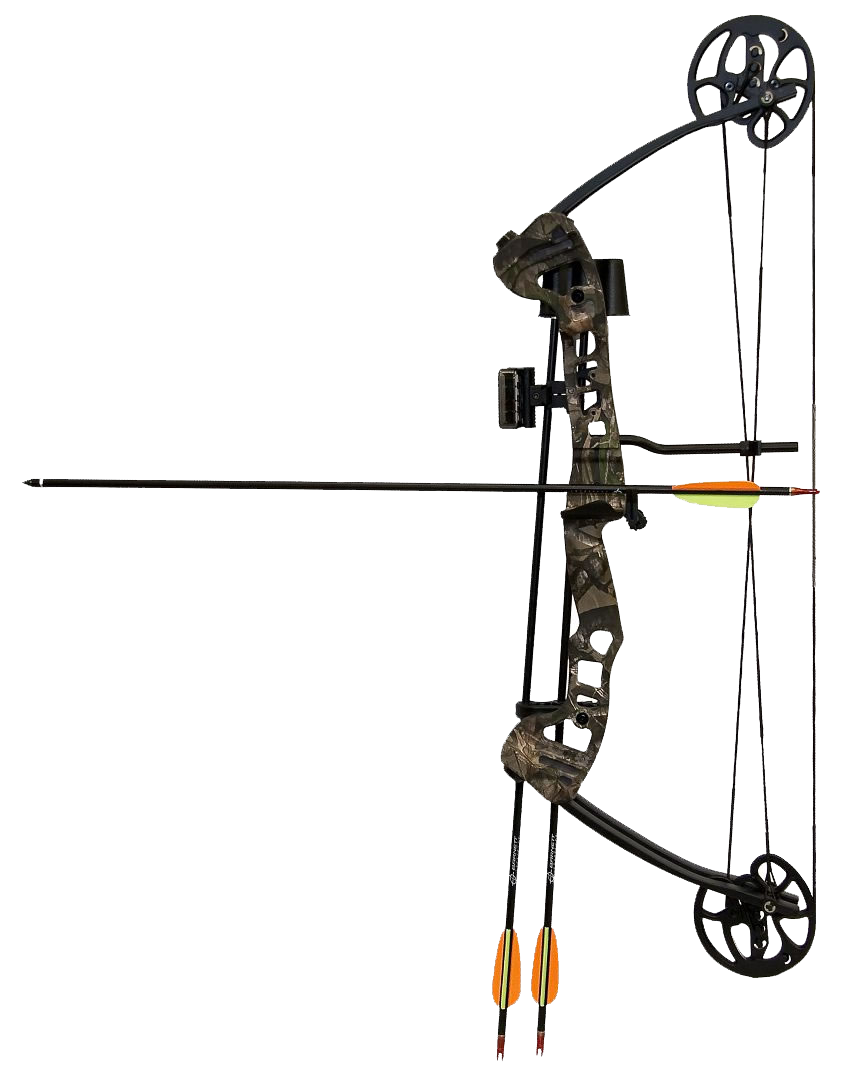
by Jackson | Jul 15, 2014 | Compound Bows
The Barnett Vortex is a youth bow that provides a “real compound bow” that also gives you room to grow and adjust for your needs. Having a compound bow that can grow and adjust to a young archer is a challenge, but I believe the Barnett Vortex is an excellent bow to fill that need. The problem with a compound bow is that you must have it specifically fitted to one person. This personal fitting is how you get the let off advantage from a compound bow.
Barnett Vortex Youth Compound Bow Package
The Barnett Vortex is that happy medium that lets you tune the bow to an individual archer. You can adjust it to fit a variety of archers.
Bow specifications
- Draw weight – 19-45 lbs
- Draw length – 22″ – 27″
- Let off of 60-70%
What’s included
- The bow
- 3 aluminum arrows
- Arrow Rest
- 3 Pin Sight
- 3 arrow quiver
Not included
Special notes
- Right handed use
- Camo pattern finish
The pros
This bow is a huge improvement from a “toy bow.” This is the real thing! The bow is solidly made to ATA/AMO standards and provides a great amount of let off which is the purpose for getting a compound in the first place. You can get some serious performance on a budget. You do get everything you need to start shooting immediately. The only thing you’ll need to do is adjust the sights if you choose to use them.
The cons
As with most beginner bows, the bow itself is the strong point. The weak points are with the accessories. You should consider getting more arrows from the beginning. This goes with all archers though. I highly recommend carbon arrows as they are much sturdier. The arrow rest can also be replaced if you want.
The only other thing you need to know is that the bow is adjustable, but you can’t get all draw weights at all draw lengths. The smaller the draw length, the lower the weight. The idea is that a person with a longer draw length will be able to handle a higher draw weight.
Barnett Vortex Youth Compound Bow Package
Overall, this is a great bow that will last you multiple years. Priced around $130-160, you’ll get a great deal.
Some of these links go to Amazon. They are affiliate links and I will make a small commission if you choose to make a purchase. It will not affect your price at all. It will go to helping make this a better site and resource for others. This Lil Banshee bow review is 100% my own opinion.
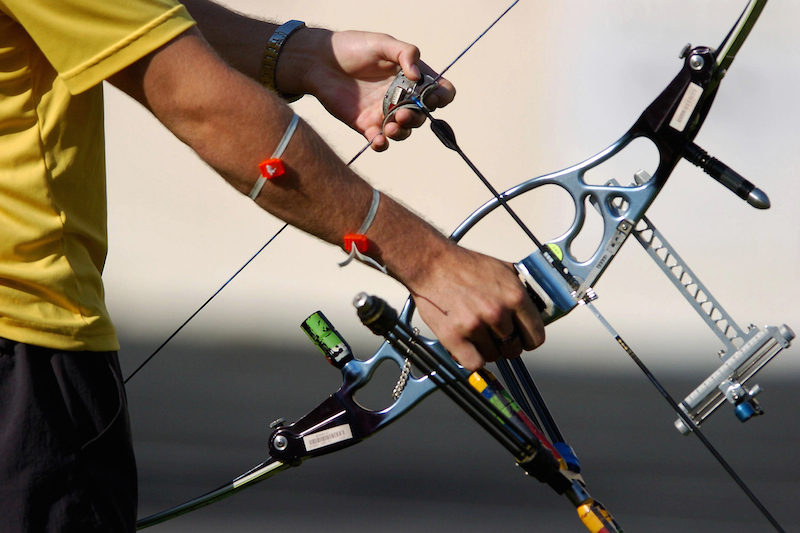
by Jackson | Jul 7, 2014 | Archery Education
Be the next Katniss or Hawkeye! Pick whatever awesome character inspires you. Robin Hood, the animated movie, was what inspired me. Getting a fiberglass recurve bow was the other part. It was amazing and I loved it. Fast forward a few years and you’ll find that picking archery up again wasn’t so easy.
Getting the right information about archery, how to shoot, what kinds of things you can do, and where to go shoot are just a few of the many questions that I had when I was getting back into archery after college. I didn’t think it would be right to be telling you about all the right stuff without proving that I know the right stuff. I do know the right things, but since there’s so much junk out on the internet, I want you to know that I care.
Learn archery from me
Here are the two things that I’m doing that I think will really help you out.
I’m getting certified as an instructor
I’m a believer showing you care and not just saying you care. I know how to shoot and I feel like I shoot pretty good, but I don’t want to just tell you what gear is the best and where else you can go for information, I want to give you the information and getting certified as an archery coach will not only make sure that you’re getting the right information, but it will also help me shoot better too.
I’m creating an introduction to archery video course
This is something I really wish I had when I started. I didn’t have access to a coach and there’s a lot more to learn than you can pick up from a sales rep at a store, especially when his goal is to get you to buy a bow.
The video course will cover several different things and should be a great resource to help you shoot very accurately from the beginning.
What it covers:
- Parts of a bow
- choosing a bow
- proper shooting form
- instinctive shooting
- shooting with sights
- practice drill ideas
- lots of other tips such as finding locations to shoot, tips for people with no land, and how to find more local information.
Sorry for the absence for the past couple weeks. I’ve learned how to make videos so that I could put this together. It’s been worth it though. I really feel that you’ll be getting a great value by learning with this and that it really is the next best thing to having a one on one personal coach.
If you sign up for my newsletter, you’ll automatically get notified when it’s out and you’ll also get a discount that will be exclusively for those who read my newsletter.
Shoot Straight











